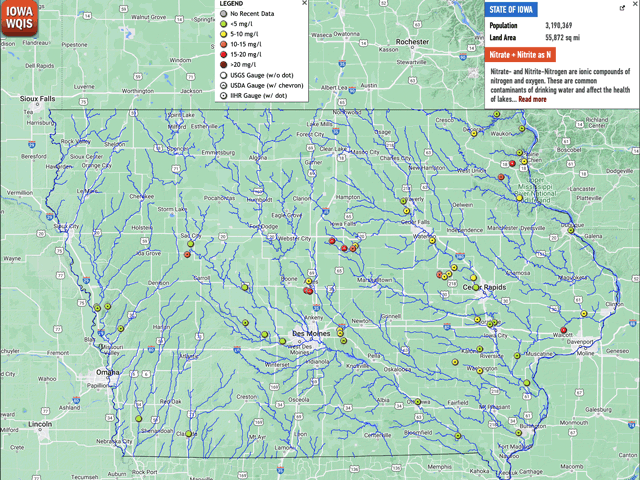Iowa Cuts Water Quality Testing Data
Touting 10 Years of Iowa's Nutrient Reduction Plan, Lawmakers Cut Funds for Water Testing
OMAHA (DTN) -- The Iowa Legislature is marking the 10-year anniversary of the state's voluntary nutrient reduction strategy by eliminating state funding for the water testing sensors that validate the state's efforts to reduce nitrogen and phosphorus in streams and rivers.
The Iowa House on Tuesday passed a funding bill for agriculture and natural resources that shifts $500,000 from the Iowa Nutrient Research Center at Iowa State University and sends the funds to a conservation program in the Iowa Department of Agriculture and Land Stewardship, the Cedar Rapids Gazette reported.
The funding has been used as part of a collaboration between the Nutrient Research Center and the University of Iowa to fund about 70 sensors each year in Iowa streams and rivers to measure nitrate loads in real time for the Iowa Water Quality Information System. The sensors help gauge the value of conservation practices employed around the state to reduce nutrient runoff. They also help downstream water utilities gauge nutrient loads in waterways.
Stripping the water-testing funds also comes as state officials, conservation and farm groups are marking 10 years since state officials rolled out the Iowa Nutrient Reduction Strategy -- the plan to meet Iowa commitments to reduce nitrogen loads in rivers by 45% and reduce phosphorus by 29%.
Alicia Vasto, water program director for the Iowa Environmental Council, a non-profit group in the state, said the state hasn't released a comprehensive progress report on the nutrient reduction strategy since 2019, though a new report is expected soon. Other research has shown, however, the nitrogen numbers are not hitting Iowa's targets.
"The amount of nitrogen that is leaving the state is increasing, so we're moving in the wrong direction, and that's what these sensors show," Vasto said.
Vasto said the sensor data provides the best information to evaluate the nutrient reduction strategy. The Iowa Environmental Council has been calling for more monitoring and testing across the state.
P[L1] D[0x0] M[300x250] OOP[F] ADUNIT[] T[]
"If it was showing that we were making progress on the nutrient reduction strategy, we certainly wouldn't be pulling them right now," she said.
The Iowa Senate last week first approved shifting the water-quality testing funds in a bill led by state Sen. Dan Zumbach, a Republican from Ryan, Iowa. RadioIowa reported Zumbach said in debate over the bill that shifting the money from water testing would help through more on-the-ground practices.
"What we do know is practices on the land and in our towns is what makes cleaner water," Zumbach said. "And so, when we made the decisions on how to appropriate dollars, it was all about let's put practices that help clean our water."
Yet Zumbach has been tied to the permitting of Supreme Beef, an 11,600-head cattle feedyard owned by Zumbach's son-in-law in northeast Iowa near the headwaters of a trout stream called Bloody Run Creek. On April 30, just days after the Iowa Senate approved the shift in funding away from water-quality testing, an Iowa judge ruled that the Iowa Department of Natural Resources improperly granted a permit for the nutrient-management plan on the feedyard. The ruling sent the permit back to the Iowa DNR, which could appeal the ruling or require Supreme Beef to refile a new nutrient management plan. The case was brought by the Sierra Club of Iowa and Trout Unlimited.
The judge in the case, Scott Rosenberg, was critical of the Iowa DNR permitting for the feedyard and questioned the state's calculations on the volume of manure as well the risks of spills and leaks into porous bedrock. Zumbach had contacted the Iowa DNR director about the permit, which was then changed from 11,600 head to 2,700 cattle. A few months later the feedyard reapplied and was granted approval for another 8,900 cattle.
The Iowa Agriculture Water Alliance this month is spotlighting the Iowa Nutrient Reduction Strategy, which was created in 2013 following the EPA request for 12 states along the Mississippi River to develop action plans to reduce nutrient runoff that adds to the hypoxia zone in the Gulf of Mexico. The alliance has field days lined up in parts of the state this month to spotlight conservation practices on farms.
"We have a lot to be proud of -- from 3 million acres of cover crops to 15 million acres of no-till, strip till and conservation tillage, to a 650% increase in new edge-of-field practices year-over-year," said Sean McMahon, executive director of IAWA, in a news release. "Just as important to note, though, is the work that we still have to do over the next decade and beyond -- particularly for nitrogen loss reduction."
Iowa Gov. Kim Reynolds last week also proclaimed April 30-May 7 as "Soil and Water Conservation Week" and the state is releasing funding announcements for conservation projects.
"Soil and Water Conservation Week is a timely reminder that all Iowans can play a vital role in improving our water quality and protecting our valuable soil," said Iowa Secretary of Agriculture Mike Naig in a news release. "While we have made a lot of conservation and water quality progress over the past decade, we must focus on accelerating that work in years to come. We are excited about the water quality momentum that is building across our state."
Naig also is co-chairman of the EPA Mississippi River/Gulf of Mexico Hypoxia Task Force, the state-federal group meant to oversee nutrient reduction targets in the Mississippi River. Naig's office did not respond to questions about how to validate Iowa's progress if water-testing sensors are removed.
Naig's office did not respond to questions about the water-quality testing funds.
DTN also reached out to the Iowa Farm Bureau but did not receive a response.
Iowa Water Quality Information System: https://iwqis.iowawis.org/…
The Iowa Nutrient Research Center: https://www.cals.iastate.edu/…
Chris Clayton can be reached at Chris.Clayton@dtn.com
Follow him on Twitter @ChrisClaytonDTN
(c) Copyright 2023 DTN, LLC. All rights reserved.




